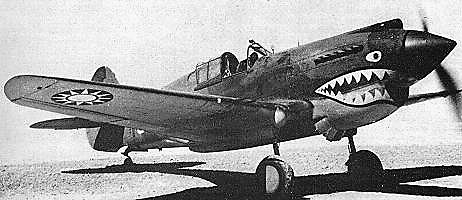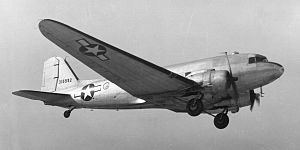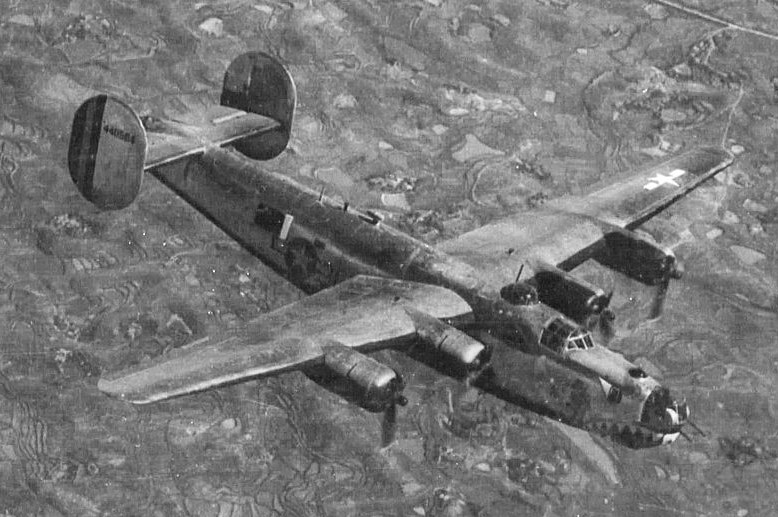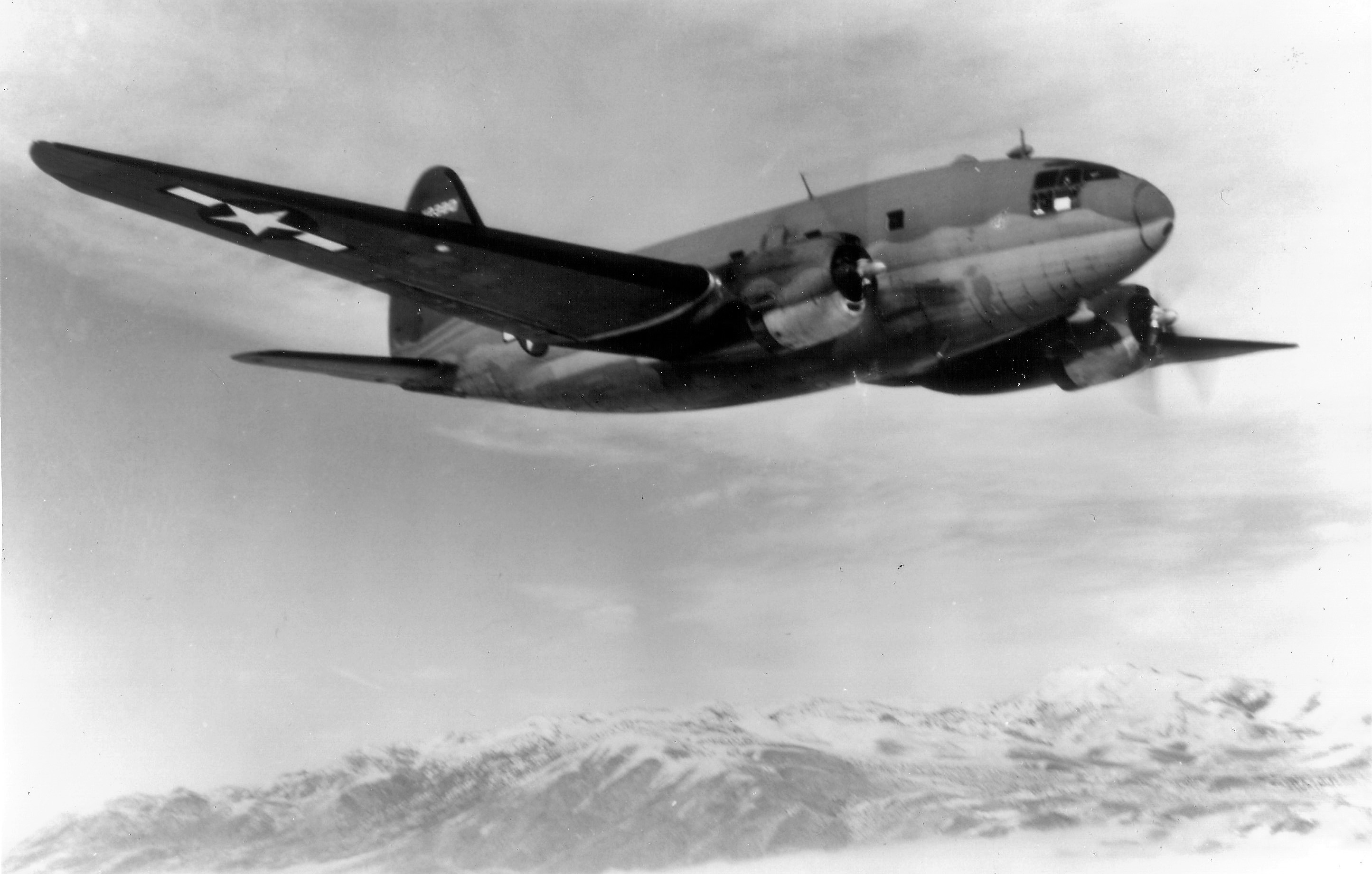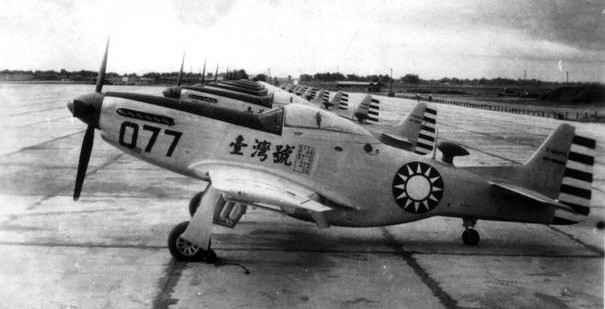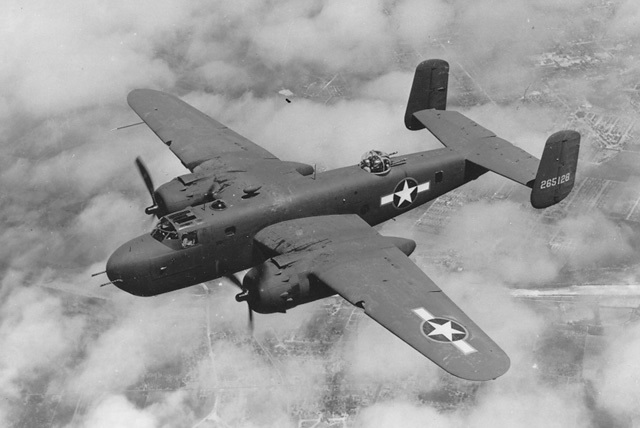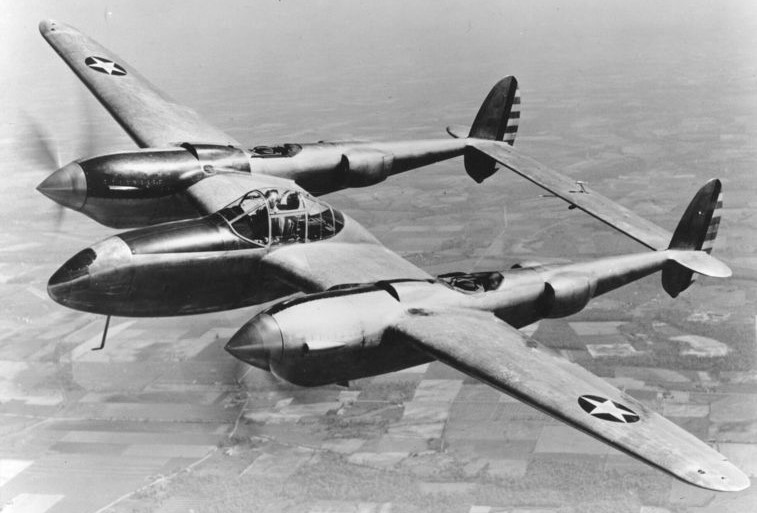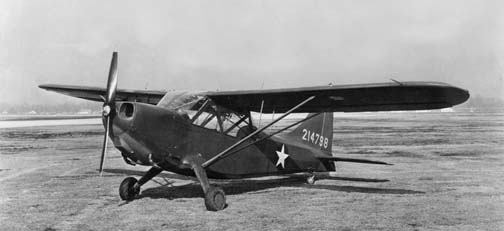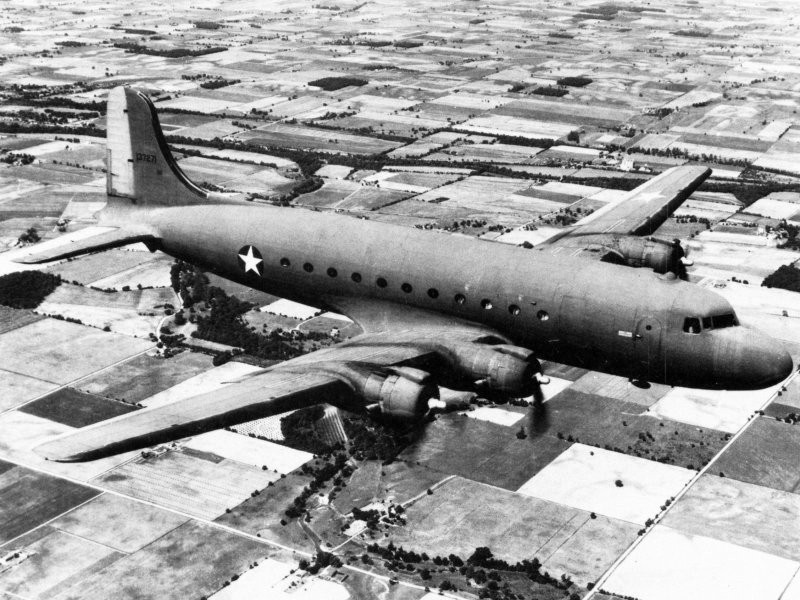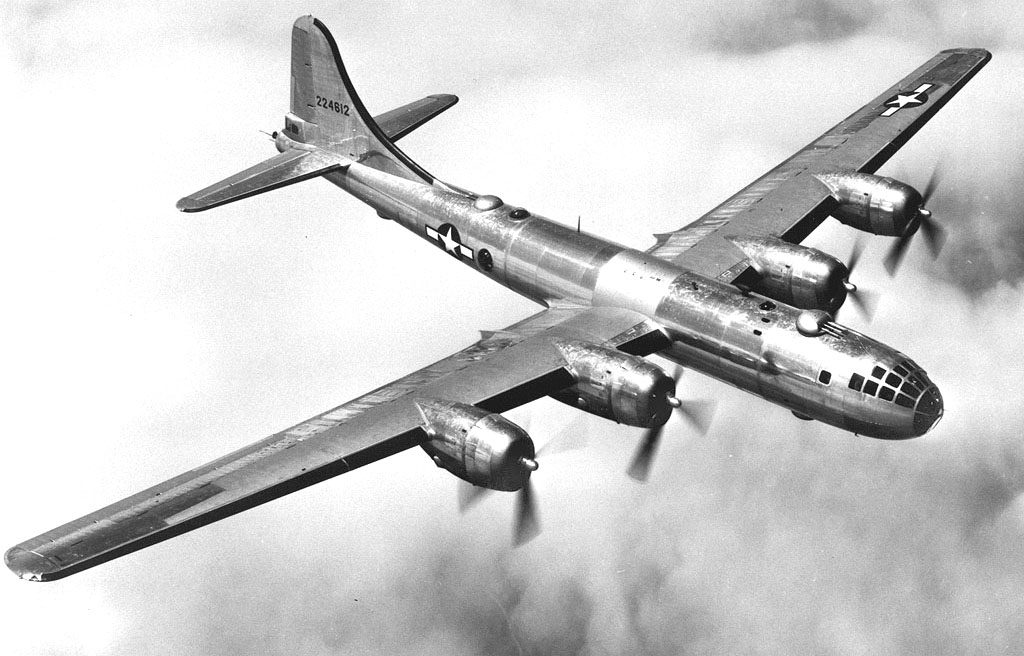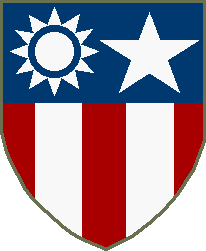 |
Curtiss P-40 Warhawk
Flying Tigers Fighter
The Curtiss P-40 Warhawk is an American single-engined, single-seat, all-metal fighter and ground-attack aircraft that first flew in 1938. The P-40 design was a modification of the previous Curtiss P-36 Hawk which reduced development time and enabled a rapid entry into production and operational service.The Warhawk was used by most Allied powers during World War II, and remained in frontline service until the end of the war. It was the third most-produced American fighter, after the P-51 and P-47; by November 1944, when production of the P-40 ceased, 13,738 had been built, all at Curtiss-Wright Corporation's main production facilities at Buffalo, New York.
P-40 Warhawk was the name the United States Army Air Corps and after June 1941, USAAF-adopted name for all models, making it the official name in the United States for all P-40s. The British Commonwealth and Soviet air forces used the name Tomahawk for models equivalent to the P-40B and P-40C, and the name Kittyhawk for models equivalent to the P-40D and all later variants.
P-40s first saw combat with the British Commonwealth squadrons of the Desert Air Force in the Middle East and North African campaigns, during June 1941. No. 112 Squadron Royal Air Force, was among the first to operate Tomahawks in North Africa and the unit was the first Allied military aviation unit to feature the "shark mouth" logo, copying similar markings on some Luftwaffe Messerschmitt Bf 110 twin-engine fighters.
The P-40's lack of a two-speed supercharger made it inferior to Luftwaffe fighters such as the Messerschmitt Bf 109 or the Focke-Wulf Fw 190 in high-altitude combat and it was rarely used in operations in Northwest Europe. However, between 1941 and 1944, the P-40 played a critical role with Allied air forces in three major theaters: North Africa, the Southwest Pacific, and China. It also had a significant role in the Middle East, Southeast Asia, Eastern Europe, Alaska and Italy. The P-40's performance at high altitudes was not as important in those theaters, where it served as an air superiority fighter, bomber escort and fighter-bomber. Although it gained a postwar reputation as a mediocre design, suitable only for close air support, recent research including scrutiny of the records of individual Allied squadrons indicates that this was not the case: the P-40 performed surprisingly well as an air superiority fighter, at times suffering severe losses but also taking a very heavy toll of enemy aircraft. The P-40 offered the additional advantage of low cost, which kept it in production as a ground-attack aircraft long after it was obsolete as a fighter. In 2008, 29 P-40s were airworthy.
The Flying Tigers, known officially as the 1st American Volunteer Group (AVG), were a unit of the Chinese Air Force, recruited from U.S. aviators. From late 1941, the P-40B was used by the Flying Tigers.They were divided into three pursuit squadrons, the "Adam & Eves", the "Panda Bears" and the "Hell's Angels".
Compared to opposing Japanese fighters, the P-40B's strengths were that it was sturdy, well armed, faster in a dive and possessed an excellent rate of roll. While the P-40s could not match the maneuverability of the Japanese Army air arm's Nakajima Ki-27s and Ki-43s, nor the much more famous Zero naval fighter in a slow speed turning dogfight, at higher speeds the P-40s were more than a match.
AVG leader Claire Chennault trained his pilots to use the P-40's particular performance advantages.The P-40 had a higher dive speed than any Japanese fighter aircraft of the early war years, for example, and could be used to exploit so-called "boom-and-zoom" tactics. The AVG was highly successful, and its feats were widely published, to boost sagging public morale at home, by an active cadre of international journalists. According to their official records, in just 6 1/2 months, the Flying Tigers destroyed 115 enemy aircraft for the loss of just four of their own in air-to-air combat.
The Model B's received by Chennault and assembled in Burma at the end of 1941 were not well liked.
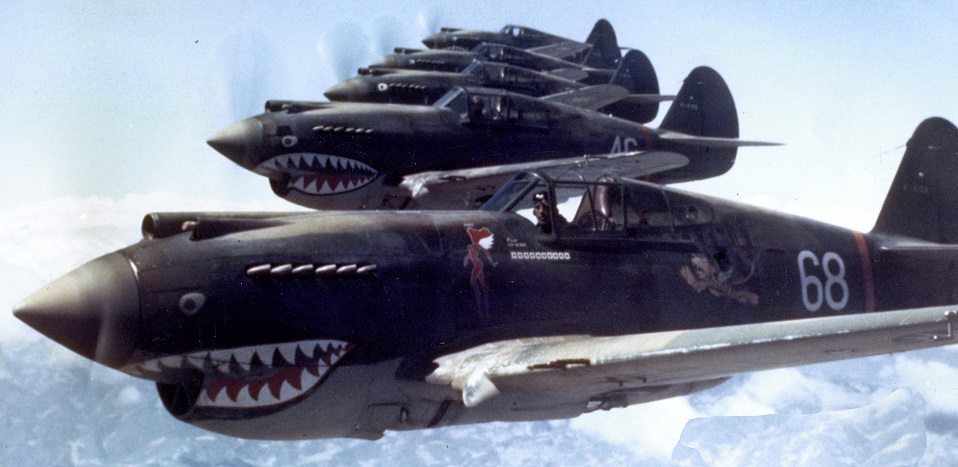 |
Because the plane lacked a turbo-supercharger, its effective ceiling was about 25,000 feet. The most critical problem was the lack of spare parts; the only source of spare parts was damaged aircraft. The planes were thought to be what no one else wanted, dangerous and difficult to fly. But the plane had advantages: its gas tanks were self-sealing and could take hits without catching on fire. There were two heavy sheets of steel behind the pilot's head and back. The plane as a whole was ruggedly constructed.
In the spring of 1942, the AVG received a small number of Model E's, each equipped with a radio, six .50-caliber machine guns,and auxiliary bomb racks that could hold 35-lb fragmentation bombs. Chennault's armorer fitted the new planes with additional bomb racks that held the 570-lb Russian bombs, which the Chinese had in abundance. These planes were used in the battle of the Salween River Gorge in late May, 1942, which kept the Japanese from entering China from Burma and threatening Kunming. Spare parts were still a problem. "Scores of new planes...were now in India, and there they stayed--in case the Japanese decided to invade....the AVG was lucky to get a few tires and spark plugs with which to carry on its daily war."
4th Air GroupChina received 27 P-40E in early 1943. These were assigned to squadrons of the 4th Air Group.
The U.S. Army Air Force used the designation "P" for "Pursuit" for aircraft designed for air-to-air combat roles.Following the war, with the formation of the U.S. Air Force, aircraft designed for air-to-air combat were designated "F" for "Fighter."There is no difference in roles between the two designations.
| ||||||||||||||||||||||||||||||||||||||||
Douglas C-47 Skytrain
First To Fly The Hump
The Douglas C-47 Skytrain is a military transport aircraft developed from the civilian Douglas DC-3 airliner. It was used extensively by the Allies during World War II and remains in front line service with various military operators to the present day.
The military career of the Douglas DC series began in 1936, when the U.S. Army Air Corps ordered a pair of DC-2 commercial transports under the designation C-32. A contract followed for 18 DC-2s in the C-33 freighter configuration and two more as C-34 staff transports. Then, in 1937, the U.S. Army ordered a plane built to its own specifications. It was a hybrid design that combined the fuselage of the DC-2 with a DC-3 tail. This was the sole C-38 prototype, and it led to 35 production versions called the C-39. The C-39 represented the first serious effort by the Army to establish an airlift capability.
By 1941, the old Air Corps had been transformed into the Army Air Forces, and it selected a modified version of the DC-3 the C-47 Skytrain to become its standard transport aircraft. A reinforced fuselage floor and the addition of a large cargo door were the only major modifications. Other changes included the fitting of cargo hooks beneath the center wing section and the removal of the tail cone to mount a hook for towing gliders.
As a supply plane, the C-47 could carry up to 6,000 pounds of cargo. It could also hold a fully assembled jeep or a 37 mm cannon. As a troop transport, it carried 28 soldiers in full combat gear. As a medical airlift plane, it could accommodate 14 stretcher patients and three nurses.
The C-47 was vital to the success of many Allied campaigns, in particular those at Guadalcanal and in the jungles of New Guinea and Burma, where the C-47 (and its naval version, the R4D) made it possible for Allied troops to counter the mobility of the light-traveling Japanese army. Additionally, C-47s were used to airlift supplies to the embattled American forces during the Battle of Bastogne. Possibly its most influential role in military aviation, however, was flying "The Hump" from India into China. The expertise gained flying "The Hump" was later be used in the Berlin Airlift, in which the C-47 played a major role, until the aircraft were replaced by Douglas C-54 Skymasters.
A C-47 flown by the China National Airways Corporation (CNAC) pilot Moon Chin, who had previously flown "The Hump" in the aircraft, had a role in the Doolittle Raid. Moon Chin was tasked with flying from Chungking to Myitkyina, a military base in Burma. His aircraft was "jumped" by Japanese fighters and, after landing at a small hidden airstrip to wait for his pursuers to give up the game, he planned to resume his flight to Myitkyina. One of his passengers, "an unshaven, balding, bedraggled American" who was dressed in a combination of civilian clothing and an Army uniform, suggested that he fly to a field in India since the American had heard that Myitkyina had fallen to the Japanese. When Chin's DC-3 arrived at Myitkyina, he found that the base had, indeed, been severely bombed by the Japanese and hundreds of people were milling around the airdrome. Eventually, Chin would carry sixty-eight passengers and a crew of four (including eight stowaways in the aft compartment he did not know about) on the final leg to India. After arriving in India, the tattered American approached Captain Chin and thanked him for the ride.
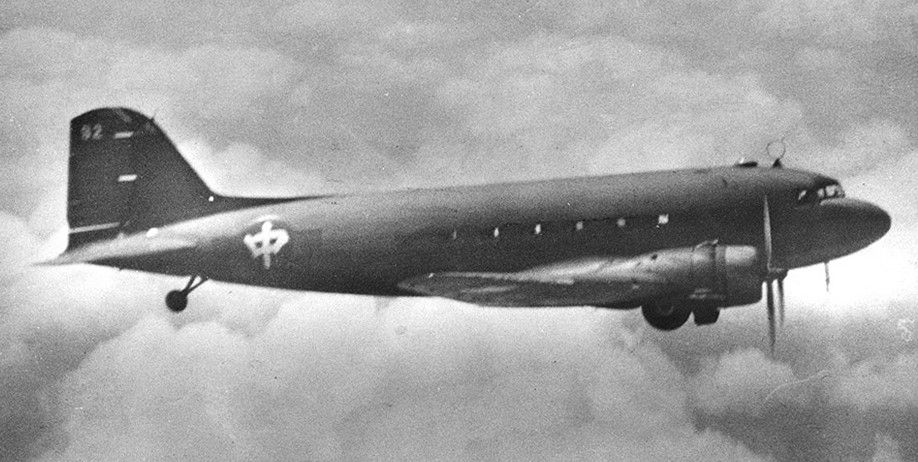 |
In Europe, the C-47 and a specialized paratroop variant, the C-53 Skytrooper, were used in vast numbers in the later stages of the war, particularly to tow gliders and drop paratroops. During the invasion of Sicily in July 1943, C-47s dropped 4,381 Allied paratroops. More than 50,000 paratroops were dropped by C-47s during the first few days of the invasion of Normandy, France, in June 1944.In the Pacific War, with careful use of the island landing strips of the Pacific Ocean, C-47s were even used for ferrying soldiers serving in the Pacific theater back to the United States.
About 2,000 C-47s (received under lend-lease) in British and Commonwealth service took the name "Dakota", possibly inspired by the acronym "DACoTA" for Douglas Aircraft Company Transport Aircraft.The C-47 also earned the informal nickname "gooney bird" in the European theater of operations.Other sources attribute this name to the first aircraft, a USMC R2D the military version of the DC-2 being the first aircraft to land on Midway Island, previously home to the native long-winged albatross known as the gooney bird, which was native to Midway.
Every branch of the U.S military and all the major allied powers flew it. The U.S. Navy version was the R4D. The British and the Australians designated it the Dakota (a clever acronym composed of the letters DACoTA for Douglas Aircraft Company Transport Aircraft). The aircraft operated from every continent in the world and participated in every major battle. By the end of World War II, more than 10,000 had been built. For all of its official and unofficial names, it came to be known universally as the Gooney Bird ; General Dwight D. Eisenhower, Supreme Commander of Allied Forces in Europe, termed it one of the most vital pieces of military equipment used in winning the war.
| ||||||||||||||||||||||||||||||||||||||||||
Consolidated B-24 Liberator
Most-Produced American Military Aircraft
The Consolidated B-24 Liberator is an American heavy bomber, designed by Consolidated Aircraft of San Diego, California. It was known within the company as the Model 32, and some initial models were laid down as export models designated as various LB-30s, in the Land Bomber design category.
At its inception, the B-24 was a modern design featuring a highly efficient shoulder-mounted, high aspect ratio Davis wing. The wing gave the Liberator a high cruise speed, long range and the ability to carry a heavy bomb load. Early RAF Liberators were the first aircraft to cross the Atlantic Ocean as a matter of routine. However, the type was difficult to fly and had poor low speed performance. It also had a lower ceiling and was less robust than the Boeing B-17 Flying Fortress. While aircrews tended to prefer the B-17, General Staff preferred the B-24, and procured it for a wide variety of roles.
The B-24 was used extensively in World War II. It served in every branch of the American armed forces, as well as several Allied air forces and navies, and saw use in every theater of operations. Along with the B-17, the B-24 was the mainstay of the U.S. strategic bombing campaign in the Western European theater. Due to its range, it proved useful in bombing operations in the Pacific, including the bombing of Japan. Long range anti-submarine Liberators played an instrumental role in closing the Mid-Atlantic Gap in the Battle of the Atlantic.The C-87 transport derivative served as a longer range, higher capacity counterpart to the Douglas C-47 Skytrain.
The "Lib" was produced in very large numbers. At nearly 19,000 units, with over 8,000 manufactured by Ford Motor Company, it holds the distinction of being the most produced heavy bomber in history, the most produced multi-engine aircraft in history and the most-produced American military aircraft.
At the end of World War II, the Liberator had been surpassed by more modern types such as the Boeing B-29 Superfortress. The type was rapidly phased out of U.S. service, although the PB4Y-2 Privateer derivative would go on to see service with the U.S. Navy in the Korean War.
The United States Army Air Forces (USAAF) took delivery of its first B-24As in mid-1941. Over the next three years, B-24 squadrons deployed to all theaters of the war: African, European, China-Burma-India, the Anti-submarine Campaign, the Southwest Pacific Theater and the Pacific Theater. In the Pacific, to simplify logistics and to take advantage of its longer range, the B-24 (and its twin, the U.S. Navy PB4Y) was the chosen standard heavy bomber. By mid-1943, the shorter-range B-17 was phased out. The Liberators which had served early in the war in the Pacific continued the efforts from the Philippines, Australia, Espiritu Santo, Guadalcanal, Hawaii, and Midway Island. The Liberator peak overseas deployment was 45.5 bomb groups in June 1944. Additionally, the Liberator equipped a number of independent squadrons in a variety of special combat roles.
So vital was the need for long range operations, that at first USAAF used the type as transports. The sole B-24 in Hawaii was destroyed by the Japanese attack on Pearl Harbor on 7 December 1941. It had been sent to the Central Pacific for a very long range reconnaissance mission that was preempted by the Japanese attack.
The first USAAF Liberators to carry out combat missions
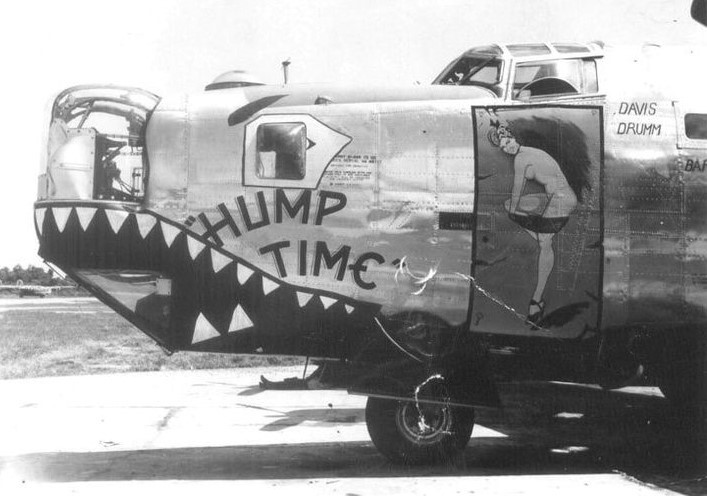 |
U.S.-based B-24s entered combat service in 1942 when on 6 June, four B-24s from Hawaii staging through Midway Island attempted an attack on Wake Island, but were unable to find it. The B-24 came to dominate the heavy bombardment role in the Pacific because compared to the B-17, the B-24 was faster, had longer range, and could carry a ton more bombs.
The C-87 cargo and C-109 tanker versions further increased its overseas presence, especially in CBI in support of the XX Bomber Command air offensive against Japan.
| ||||||||||||||||||||||||||||||||||||||||
Curtiss C-46 Commando
Hump Workhorse
The Curtiss C-46 Commando is a transport aircraft derived from the Curtiss CW-20 pressurized high-altitude airliner design. Early press reports used the name "Condor III" but the Commando name was in use by early 1942 in company publicity.It was used as a military transport during World War II by the United States Army Air Forces and also the U.S. Navy/Marine Corps, which used the designation R5C. The C-46 served a similar role to its counterpart, the Douglas C-47 Skytrain, but was not as extensively produced. At the time of its production, the C-46 was the largest twin-engine aircraft in the world, and was the largest and heaviest twin-engine aircraft to see service in World War II.
The first prototype was purchased by the United States Army Air Forces (USAAF) to serve as a master for the series and was designated "C-55" but after military evaluation, the sole example was returned to Curtiss-Wright and subsequently re-sold to the British Overseas Airways Corporation (BOAC).During testing, General Henry H. "Hap" Arnold became interested in the potential of the airliner as a military cargo transport and on 13 September 1940,ordered 46 modified CW-20As as the C-46-CU Commando; the last 21 aircraft in this order were delivered as Model CW-20Bs, called C-46A-1-CU. None of the C-46s purchased by the U.S. military were pressurized and the first 30 delivered to the AAF were sent back to the factory for 53 immediate modifications. The design was then modified to the C-46A configuration, receiving enlarged cargo doors, a strengthened load floor and a convertible cabin that speeded changes in carrying freight and troops. The C-46 was introduced to the public at a ceremony in May 1942, attended by its designer, George A. Page Jr.
A total of 200 C-46As in two initial batches were ordered in 1940, although only two were actually delivered by December 7, 1941.At this time, one other important change was made; more powerful 2,000 hp Pratt & Whitney R-2800 Double Wasp engines replaced the two Wright Twin Cyclones. By November 1943, 721 modifications had been made to production models, although many were minor, such as fuel system changes and fewer cabin windows were also adopted. Subsequent military contracts for the C-46A extended the production run to 1,454 examples, 40 of which were destined for the U.S. Marine Corps, to be designated R5C-1. The military model was fitted with double cargo doors, a strengthened floor and hydraulically operated cargo handling winch; 40 folding seats were the sole passenger accommodation for what was essentially a cargo hauler.Tests indicated that the production C-46 was capable of carrying a substantial payload, and could fly well on one engine. When empty, the aircraft could even climb on one engine at 200 300 ft per minute.
The final large production-run C-46D arrived in 1944 45, and featured single doors to facilitate paratroop drops; production totaled 1,430 aircraft.Although a one-off XC-46B experimented with a stepped windscreen and uprated powerplants, a small run of 17 C-46Es had many of the same features as the XC-46B along with three-bladed Hamilton-Standard propellers replacing the standard Curtiss-Electric four-bladed units. A last contract for 234 C-46Fs reverted to the earlier cockpit shape but introduced square wingtips. A sole C-46G had the stepped windscreen and square wingtips but the end of the war resulted in the cancellation of any additional orders for the type.
After World War II, a few surplus C-46 aircraft were briefly used in their originally designated role as passenger airliners, but the glut of surplus C-47s dominated the marketplace and the C-46 were soon relegated to primarily cargo duty. The type continued in U. S. Air Force service in a secondary role until 1968. However, the C-46 continues in operation as a rugged cargo transport for Arctic and remote locations with its service life extended into the 21st century.
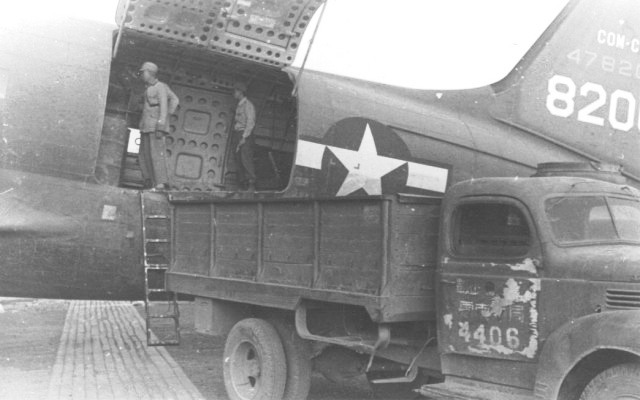 |
Most famous for its operations in the CBI Theater and the Far East, the Commando was a workhorse in flying over "The Hump" (as the Himalaya Mountains were nicknamed by Allied airmen), transporting desperately needed supplies to troops in China from bases in India.A variety of transports had been employed in the campaign, but only the C-46 was able to handle the wide range of adverse conditions encountered by the USAAF. Unpredictably violent weather, heavy cargo loads, high mountain terrain, and poorly equipped and frequently flooded airfields proved a considerable challenge to the transport aircraft then in service, along with a host of engineering and maintenance nightmares due to a shortage of trained air and ground personnel.
After a series of mechanical problems were controlled if not surmounted, the C-46 proved its worth in the airlift operation in spite of continuing maintenance headaches. It could carry more cargo higher than other Allied twin-engine transport aircraft in the theater, including light artillery, fuel, ammunition, parts of aircraft and, on occasion, livestock. Its powerful engines enabled it to climb satisfactorily with heavy loads, staying aloft on one engine if not overloaded, though "war emergency" load limits of up to 40,000 lbs often erased any safety margins. Nevertheless, after the troublesome Curtiss-Electric electrically controlled pitch mechanism on the propellers had been removed, the C-46 continued to be employed in the CBI and over wide areas of southern China throughout the war years.Even so, the C-46 was referred to by ATC pilots as the "flying coffin" with at least 31 known instances of fires or explosions in flight between May 1943 and March 1945, and many others missing and never found.Other names used by the men who flew them were "The Whale," the "Curtiss Calamity," and the "plumber's nightmare". The C-46's huge cargo volume (twice that of the C-47), three times the weight, large cargo doors, powerful engines and long range also made it suitable for the vast distances of the Pacific island campaign. In particular, the U.S. Marines found the aircraft (known as the R5C) useful in their amphibious Pacific operations, flying supplies in and wounded personnel out of numerous and hastily built island landing strips.
| ||||||||||||||||||||||||||||||||||||||
North American P-51 Mustang
Most Capable Fighter in China
The North American Aviation P-51 Mustang is an American long-range, single-seat fighter and fighter-bomber used during World War II, the Korean War and other conflicts. The Mustang was designed in 1940 by North American Aviation (NAA) in response to a requirement of the British Purchasing Commission for license-built Curtiss P-40 fighters. The prototype NA-73X airframe was rolled out on 9 September 1940, 102 days after the contract was signed and first flew on 26 October.
The Mustang was originally designed to use the Allison V-1710 engine, which, in its earlier variants, had limited high-altitude performance. It was first flown operationally by the Royal Air Force (RAF) as a tactical-reconnaissance aircraft and fighter-bomber (Mustang Mk I). The addition of the Rolls-Royce Merlin to the P-51B/C model transformed the Mustang's performance at altitudes above 15,000 ft, matching or bettering that of the Luftwaffe's fighters.The definitive version, the P-51D, was powered by the Packard V-1650-7, a license-built version of the Rolls-Royce Merlin 66 two-stage two-speed supercharged engine, and was armed with six .50 caliber M2/AN Browning machine guns.
From late 1943, P-51Bs (supplemented by P-51Ds from mid-1944) were used by the USAAF's Eighth Air Force to escort bombers in raids over Germany, while the RAF's 2 TAF and the USAAF's Ninth Air Force used the Merlin-powered Mustangs as fighter-bombers, roles in which the Mustang helped ensure Allied air superiority in 1944.The P-51 was also used by Allied air forces in the North African, Mediterranean and Italian theaters, and also served against the Japanese in the Pacific War. During World War II, Mustang pilots claimed 4,950 enemy aircraft shot down.
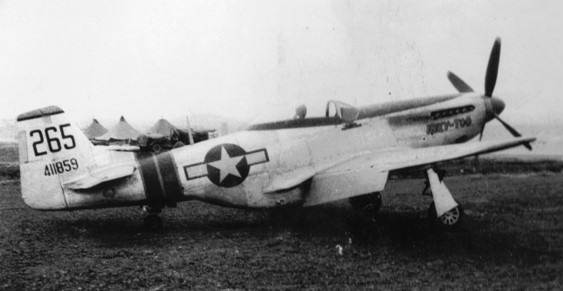 |
In early 1945, P-51C, D and K variants also joined the Chinese Nationalist Air Force. These Mustangs were provided to the 3rd, 4th and 5th Fighter Groups and used to attack Japanese targets in occupied areas of China. The P-51 became the most capable fighter in China while the Imperial Japanese Army Air Force used the Nakajima Ki-84 Hayate against it.
The P-51 was a relative latecomer to the Pacific Theater. This was due largely to the need for the aircraft in Europe, although the P-38's twin-engine design was considered a safety advantage for long over-water flights. The first P-51s were deployed in the Far East later in 1944, operating in close-support and escort missions,as well as tactical photo reconnaissance. As the war in Europe wound down, the P-51 became more common: eventually, with the capture of Iwo Jima, it was able to be used as a bomber escort during Boeing B-29 Superfortress missions against the Japanese homeland.
The P-51 was often mistaken for the Japanese Kawasaki Ki-61 Hien in both China and Pacific because of its similar appearance.
| ||||||||||||||||||||||||||||||||||||||||
North American B-25 Mitchell
Burma Bridge Buster
The North American B-25 Mitchell is an American twin-engine, medium bomber manufactured by North American Aviation (NAA). It was named in honor of Major General William "Billy" Mitchell, a pioneer of U.S. military aviation. Used by many Allied air forces, the B-25 served in every theater of World War II and after the war ended many remained in service, operating across four decades. Produced in numerous variants, nearly 10,000 Mitchells rolled from NAA factories. These included a few limited models, such as the United States Marine Corps' PBJ-1 patrol bomber and the United States Army Air Forces' F-10 reconnaissance aircraft and AT-24 trainers.
The majority of B-25s in American service were used in the war against Japan in Asia and the Pacific. The Mitchell fought from the Northern Pacific to the South Pacific and the Far East. These areas included the campaigns in the Aleutian Islands, Papua New Guinea, the Solomon Islands, New Britain, China, Burma and the island hopping campaign in the Central Pacific. The aircraft s potential as a ground-attack aircraft emerged during the Pacific war. The jungle environment reduced the usefulness of medium-level bombing, and made low-level attack the best tactic. Using similar mast height level tactics and skip bombing, the B-25 proved itself to be a capable anti-shipping weapon and sank many enemy sea vessels of various types. An ever-increasing number of forward firing guns made the B-25 a formidable strafing aircraft for island warfare. The strafer versions were the B-25C1/D1, the B-25J1 and with the NAA strafer nose, the J2 sub-series.
In Burma, the B-25 was often used to attack Japanese communication links, especially bridges in central Burma. It also helped supply the besieged troops at Imphal in 1944. The China Air Task Force, the Chinese American Composite Wing, the First Air Commando Group, the 341st Bomb Group, and eventually, the relocated 12th Bomb Group, all operated the B-25 in the China-Burma-India Theater. Many of these missions involved battle field isolation, interdiction and close air support.
Later in the war, as the AAF acquired bases in other parts of the Pacific, the Mitchell could strike targets in Indochina, Formosa and Kyushu, increasing the usefulness of the B-25. It was also used in some of the shortest raids of the Pacific War, striking from Saipan against Guam and Tinian. The 41st Bomb Group used it against Japanese-occupied islands that had been bypassed by the main campaign, such as happened in the Marshall Islands.
The B-25B first gained fame as the bomber used in the 18 April 1942 Doolittle Raid, in which 16 B-25Bs led by Lieutenant Colonel Jimmy Doolittle attacked mainland Japan, four months after the bombing of Pearl Harbor. The mission gave a much-needed lift in spirits to the Americans, and alarmed the Japanese, who had believed their home islands to be inviolable by enemy forces. Although the amount of actual damage done was relatively minor, it forced the Japanese to divert troops for home defense for the remainder of the war.
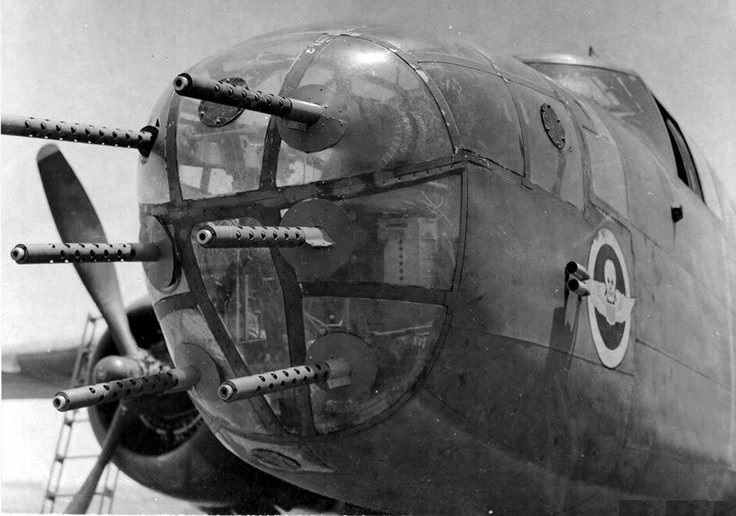 |
The raiders took off from the carrier USS Hornet and successfully bombed Tokyo and four other Japanese cities without loss. Fifteen of the bombers subsequently crash-landed en route to recovery fields in eastern China. These losses were the result of the task force being spotted by a Japanese vessel, forcing the bombers to take off 170 miles early, fuel exhaustion, stormy nighttime conditions with zero visibility, and lack of electronic homing aids at the recovery bases. Only one B-25 bomber landed intact, in Siberia where its five-man crew was interned and the aircraft confiscated. Of the 80 aircrew, 69 survived their historic mission and eventually made it back to American lines.
Well over 100 B-25Cs and Ds were supplied to the Nationalist Chinese during the Second Sino-Japanese War. In addition, a total of 131 B-25Js were supplied to China under Lend-Lease.
The four squadrons of the 1st BG (1st, 2nd, 3rd, and 4th) of the 1st Medium Bomber Group were formed during the war. They formerly operated Russian-built Tupolev SB bombers, then transferred to the B-25. The 1st BG was under the command of CACW (Chinese-American Composite Wing) while operating B-25s. Following the end of the war in the Pacific, these four bombardment squadrons were established to fight against the Communist insurgency that was rapidly spreading throughout the country. During the Chinese Civil War, Chinese Mitchells fought alongside de Havilland Mosquitos.
| ||||||||||||||||||||||||||||||||||||||
Lockheed P-38 Lightning
Unique Twin-boom Fighter
The Lockheed P-38 Lightning was a World War II American propeller-driven fighter aircraft. Developed to a United States Army Air Corps requirement, the P-38 had distinctive twin booms and a single, central nacelle containing the cockpit and armament. Named "fork-tailed devil" by the Luftwaffe and "two planes, one pilot" by the Japanese, the P-38 was used in a number of roles, including interception, dive bombing, level bombing, ground attack, night fighting, photo reconnaissance, radar and visual pathfinding for bombers, and evacuation missions, and extensively as a long-range escort fighter when equipped with drop tanks under its wings.
The P-38 was used most successfully in the Pacific Theater of Operations and the China-Burma-India Theater of Operations as the aircraft of America's top aces, Richard Bong (40 victories), Thomas McGuire (38 victories) and Charles H. MacDonald (36 victories). In the South West Pacific theater, the P-38 was the primary long-range fighter of United States Army Air Forces until the appearance of large numbers of P-51D Mustangs toward the end of the war.
The P-38 was unusually quiet for a fighter, the exhaust muffled by the turbo-superchargers. It was extremely forgiving and could be mishandled in many ways, but the rate of roll in the early versions was too slow for it to excel as a dogfighter. The P-38 was the only American fighter aircraft in production throughout American involvement in the war, from Pearl Harbor to Victory over Japan Day. At the end of the war, orders for 1,887 were cancelled.
The P-38 was used most extensively and successfully in the Pacific theater, where it proved ideally suited, combining excellent performance with very long range, and had the added reliability of two engines for long missions over water. The P-38 was used in a variety of roles, especially escorting bombers at altitudes between 18 25,000 ft. The P-38 was credited with destroying more Japanese aircraft than any other USAAF fighter.Freezing cockpits were not a problem at low altitude in the tropics. In fact, since there was no way to open a window while in flight as it caused buffeting by setting up turbulence through the tailplane, it was often too hot; pilots taking low altitude assignments would often fly stripped down to shorts, tennis shoes, and parachute. While the P-38 could not out-turn the A6M Zero and most other Japanese fighters when flying below 200 mph, its superior speed coupled with a good rate of climb meant that it could utilize energy tactics, making multiple high-speed passes at its target. Also, its focused firepower was even more deadly to lightly armored Japanese warplanes than to the Germans'. The concentrated, parallel stream of bullets allowed aerial victory at much longer distances than fighters carrying wing guns. It is therefore ironic that Dick Bong, the United States' highest-scoring World War II air ace (40 victories solely in P-38s), would fly directly at his targets to make sure he hit them (as he himself acknowledged his poor shooting ability), in some cases flying through the debris of his target (and on one occasion colliding with an enemy aircraft which was claimed as a "probable" victory). The twin Allison engines performed admirably in the Pacific.
General George C. Kenney, commander of the USAAF Fifth Air Force operating in New Guinea, could not get enough P-38s; they had become his favorite fighter in November 1942 when one squadron, the 39th Fighter Squadron of the 35th Fighter Group, joined his assorted P-39s and P-40s. The Lightnings established local air superiority with their first combat action on 27 December 1942.Kenney sent repeated requests to Arnold for more P-38s, and was rewarded with occasional shipments of them, but Europe was a higher priority in Washington.Despite their small force, Lightning pilots began to compete in racking up scores against Japanese aircraft.
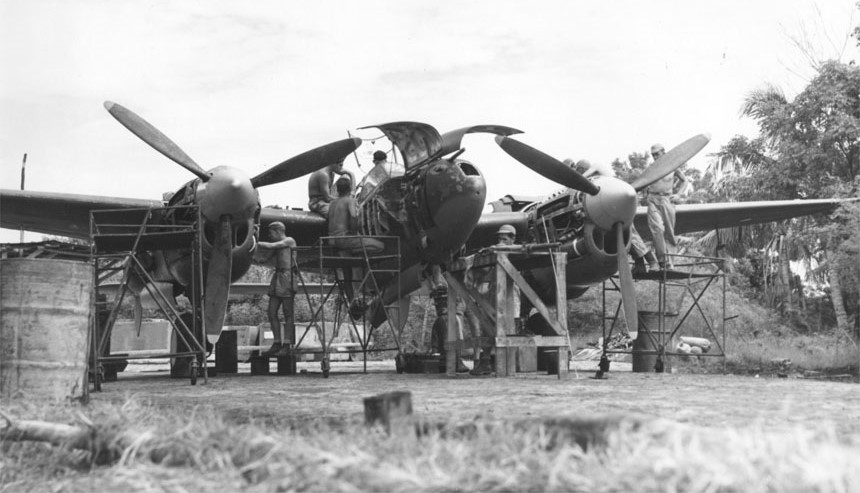 |
On 2 4 March 1943, P-38s flew top cover for 5th Air Force and Australian bombers and attack aircraft during the Battle of the Bismarck Sea, a crushing defeat for the Japanese. Two P-38 aces from the 39th Fighter Squadron were killed on the second day of the battle: Bob Faurot and Hoyt "Curley" Eason (a veteran with five victories who had trained hundreds of pilots, including Dick Bong).
The Lightning figured in one of the most significant operations in the Pacific theater: the interception, on 18 April 1943, of Admiral Isoroku Yamamoto, the architect of Japan's naval strategy in the Pacific including the attack on Pearl Harbor. When American codebreakers found out that he was flying to Bougainville Island to conduct a front-line inspection, 16 P-38G Lightnings were sent on a long-range fighter-intercept mission, flying 435 miles from Guadalcanal at heights from 10 50 ft above the ocean to avoid detection. The Lightnings met Yamamoto's two Mitsubishi G4M "Betty" fast bomber transports and six escorting Zeros just as they arrived. The first Betty crashed in the jungle and the second ditched near the coast. Two Zeros were also claimed by the American fighters with the loss of one P-38. Japanese search parties found Yamamoto's body at the jungle crash site the next day
| |||||||||||||||||||||||||||||||||||||||||
Stinson L-5 Sentinel
Flying Jeep
The Stinson L-5 Sentinel was a World War II era liaison aircraft used by the U.S. Army Air Forces, Ground Forces, Marine Corps and the British Royal Air Force. Along with the Stinson L-1 Vigilant, the L-5 was the only other American liaison aircraft of World War II that was purpose-built for military use and had no civilian counterpart. All other military liaison airplanes adopted during World War II were lightly modified "off-the-shelf" civilian models.
The origins of the L-5, affectionately known as the "Flying Jeep", can be traced to the prewar civilian Stinson HW-75. The 75 horsepower civilian high-wing design was built by the Stinson Aircraft Company at Wayne, Michigan and first flew in 1939. It was marketed as the Model 105. Featuring two side-by-side seats up front and a third "jumpseat" in the rear on which a small passenger could sit sideways, it was economical, spin resistant and easy to fly. It was became an instant success with aircraft owners and flight schools and by the end of 1939 Stinson was building three per day. In 1940 the 105 was upgraded to an 80 horsepower engine and with other small improvements this was marketed as the Model 10.
Stinson became a subsidiary of the Vultee Aircraft Corporation in August of 1940. Under Vultee management, an improved version was fitted with a four-cylinder engine for the 1941 model year and the type became known as the Model 10A.Fitted with a four-cylinder 90 hp Franklin engine for the 1941 model year, the type became known as the Model 10A. In the postwar era, the fuselage of the Model 10A was enlarged to accommodate four seats and the four-cylinder powerplant was replaced with a Franklin 150 hp six-cylinder engine. This conversion became the Stinson Model 108 Voyager and the only civilian aircraft commercially produced by Stinson after World War II.
During the summer of 1940, Stinson built an experimental tandem-seat version of the HW-75, equipping it with a 100 horsepower engine. This was known as the Model 75B. Under Vultee management it was re-designated V-75B. Soon increased to 125 horsepower for better performance, this became the V-75C that was demonstrated to the military but failed to meet their requirements. So, Stinson went back to the drawing board and came up with a clean-sheet design that was similar in concept to the V-75C but was a far stronger, more powerful and completely new tandem-seat airplane that met rigorous Army engineering handbook standards for the design of military aircraft. The 175 horsepower experimental prototype, designated as the Model V-76 and dubbed "the Flying Jeep" by factory personnel, was first flown at the Stinson factory airport on June 23, 1941. Accepted by the military after accelerated service trials were completed in September,
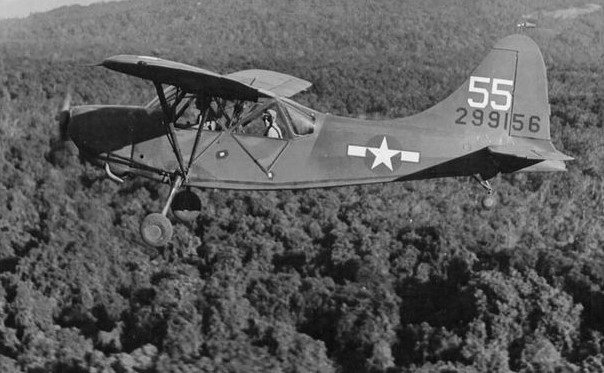 |
Adopted by the Army Air Forces as their standard liaison aircraft, replacing the larger and more costly L-1 Vigilant, its The primary purpose was short range officer transport, courier work, and artillery spotting. The fuselage of later models was redesigned so the aircraft, designated as the L-5B, could also be used as an air ambulance or for cargo work. With a wider and deeper rear fuselage section and a large rear door that folded downward, a litter patient or 250 pounds of cargo could be quickly loaded aboard. Later iterations of the ambulance version were the L-5C with provisions for mounting an aerial camera, the L-5E with drooping ailerons for better low-speed performance, the L-5E-1 with larger tires and heavy-duty brakes, and the L-5G with a 24-volt electrical system and 190 horsepower version of the Lycoming engine.
The rugged and reliable L-5 series was manufactured between December 1942 and September 1945, during which time 3,590 of the unarmed two-seaters were built, making it the second most widely used light observation liaison aircraft of the war behind the Piper L-4 Cub. By far the most common liaison type employed in the China-Burma-India (CBI) theater of operations, it was truly the unsung hero of the Burma campaigns during 1944 and 1945, earning it a reputation among British and American ground troops as the "jungle angel".
Source: J.H. Gray / Sentinel Owners & Pilots Association
| ||||||||||||||||||||||||||||||||||||||
Douglas C-54 Skymaster
Ten Tons over The Hump
The Douglas C-54 Skymaster was a four-engined transport aircraft used by the United States Army Air Forces in World War II and the Korean War. Like the Douglas C-47 Skytrain, the C-54 Skymaster was derived from a civilian airliner, the Douglas DC-4.
Besides transport of cargo, the C-54 also carried presidents, prime ministers, and military staff. Dozens of variants of the C-54 were employed in a wide variety of non-combat roles such as air-sea rescue, scientific and military research, and missile tracking and recovery. During the Berlin Airlift it hauled coal and food supplies to West Berlin.
After the Korean War it continued to be used for military and civilian uses by more than 30 countries. This was one of the first aircraft to carry the President of the United States.
C-54s began service with the USAAF in 1942, carrying up to 26 passengers, later versions carrying up to 50 passengers. The C-54 was one of the most commonly used long-range transports by the U.S. armed forces in World War II. Of the C-54s produced, 515 were manufactured in Santa Monica, California and 655 were manufactured at Orchard Place/Douglas Field, in unincorporated Cook County, Illinois, near Chicago (later the site of O'Hare International Airport).
During World War II, the C-54 was used by Franklin D. Roosevelt, Douglas MacArthur, and Winston Churchill. The American delegates to the Casablanca Conference used the Skymaster.The C-54 was also used by the Royal Air Force, the French Air Force, and the armed forces of at least 12 other nations.
President Harry S. Truman signed the National Security Act of 1947, which created the U.S. Air Force, on board "Sacred Cow", the Presidential VC-54C which is preserved at the National Museum of the United States Air Force near Dayton, Ohio. More than 300 C-54s and R5Ds formed the backbone of the U.S. contribution to the Berlin Airlift in 1948. They also served as the main airlift during the Korean War. After the Korean War, the C-54 was replaced by the Douglas C-124 Globemaster II, but continued to be used by the U.S. Air Force until 1972. The last active C-54 Skymaster in U.S. Navy service (C-54Q, BuNo 56501, of the Navy Test Pilot School, NAS Patuxent River) was retired on 2 April 1974.
In Burma, the capture of Myitkyina allowed Air Transport Command India-China Division C-54s, which had ceiling limitations that precluded flying Route Able (the High Hump), the regular use of a second, more direct route, designated Route Baker but unofficially dubbed the "Low Hump".
In October 1944, after Gen. Tunner took command of the India-China Division, increased numbers of C-54s, sometimes escorted by Allied fighters based at Myitkyina, greatly increased tonnage levels flown to China from India.
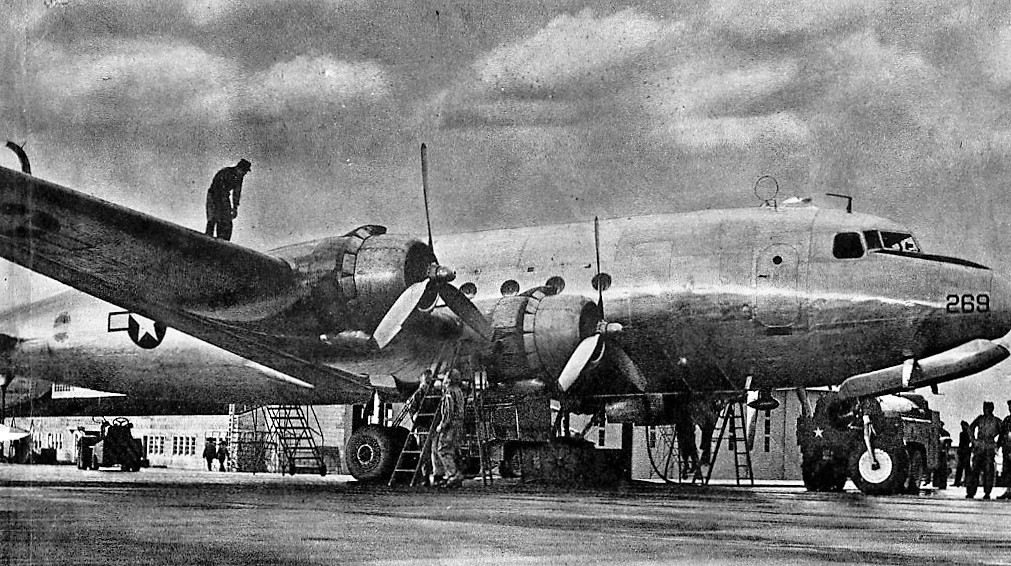 |
In late 1945, several hundred C-54s were surplus to U.S. military requirements and these were converted for civil airline operation, many by Douglas Aircraft at its aircraft plants. The aircraft were sold to airlines around the world. By January 1946, Pan American Airways was operating their Skymasters on transatlantic scheduled services to Europe and beyond. Trans-Pacific schedules from San Francisco to Auckland began on 6 June 1946.After disposal by the U.S. Air Force and U.S. Navy, many C-54s were modified for use in civilian firefighting and air tanker roles. This included fitting tanks inside and under the fuselage and the fitting of dumping and spraying equipment also on the wing trailing edges. C-54s continued in this role until the late 1990s.
| ||||||||||||||||||||||||||||||||||||||
Boeing B-29 Superfortress
Over The Hump for Operation Matterhorn
The Boeing B-29 Superfortress is a four-engine propeller-driven heavy bomber designed by Boeing and was flown primarily by the United States during World War II and the Korean War. It was one of the largest aircraft operational during World War II and very advanced for its time. It featured a pressurized cabin, all dual wheeled, tricycle landing gears, and a remote, electronic fire-control system that controlled four machine gun turrets. A manned tail gun installation was semi-remote. The name "Superfortress" continued the pattern Boeing started with its well-known predecessor, the B-17 Flying Fortress. Designed for high-altitude strategic bomber role, the B-29 also excelled in low-altitude nighttime incendiary bombing missions. One of the B-29's final roles during World War II was carrying out the atomic bomb attacks on Hiroshima and Nagasaki.
Boeing built a total of 2,766 B-29s at plants in Wichita, Kan., (previously the Stearman Aircraft Co., merged with Boeing in 1934) and in Renton, Wash. The Bell Aircraft Co. built 668 of the giant bombers in Georgia, and the Glenn L. Martin Co. built 536 in Nebraska. Production ended in 1946.
B-29s were primarily used in the Pacific Theater during World War II. As many as 1,000 Superfortresses at a time bombed Tokyo, destroying large parts of the city. Finally, on Aug. 6, 1945, the B-29 Enola Gay dropped the world's first atomic bomb on Hiroshima, Japan. Three days later a second B-29, Bockscar, dropped another atomic bomb on Nagasaki. Shortly thereafter, Japan surrendered.
Operation Matterhorn was the name given to the operation for the strategic bombing of Japanese forces by B-29 Superfortresses based in India and China. Targets included Japan itself, and Japanese bases in China and Southeast Asia. The name comes from the Matterhorn, a mountain in the Alps traditionally considered particularly difficult to climb.
The initial plan was to use B-29s to attack Japan from airfields in southern China, with the main base in India, and to attack other targets in the region from China and India as needed. This was an extremely costly scheme, as there was no overland connection available between India and China, and all the supplies had to be flown over the Himalayas. The first B-29s started to arrive in India in early April, 1944. The first B-29 flight to airfields in China (over the Himalayas, or "The Hump") took place on 24 April 1944. The first B-29 combat mission was flown on 5 June 1944, with 77 out of 98 planes launched from India bombing the railroad shops in Bangkok (5 B-29s were lost to non-battle causes).
On 5 June 1944, B-29s raided Bangkok, in what is reported as a test before being deployed against the Japanese home islands. Sources do not report from where they launched, and vary as to the numbers involved: 77, 98, and 114 being claimed. Targets were Bangkok's Memorial Bridge and a major power plant. Bombs fell over two kilometers away, damaged no civilian structures, but destroyed some tram lines and destroyed both a Japanese military hospital and the Japanese secret police headquarters.
On 15 June 1944, 47 B-29s launched from Chengtu in China bombed the Imperial Iron and Steel Works at Yawata, Japan. This was the first attack on Japanese islands since the Doolittle raid in April, 1942. The first B-29 combat loss occurred during this raid, with one B-29 destroyed on the ground by Japanese fighters after an emergency landing. Because of the extreme cost of operations, the raids against Japan from Chinese airfields continued at relatively low intensity. Japan was bombed on: 7 July 1944 (14 B-29s), 29 July (70+), 10 August (24), 20 August (61), 8 September (90), 26 September (83), 25 October (59), 12 November (29), 21 November (61), 19 December (36) and for the last time on 6 January 1945 (49). B-29s were withdrawn from airfields in China by the end of January, 1945. Throughout this period B-29 raids were also launched from China and India against many other targets throughout South-East Asia.
The need to use inconvenient bases in China for attacks against Japan ceased after the capture of the Marianas islands in 1944. On the islands of Tinian, Saipan and Guam a series of airfields were built, which became the main bases for the large B-29 raids against Japan in the final year of the war. The islands could be easily supplied by ship. The first B-29 arrived on Saipan on 12 October 1944, and the first combat mission was launched from there on 28 October 1944, with 14 B-29s attacking the Truk atoll.
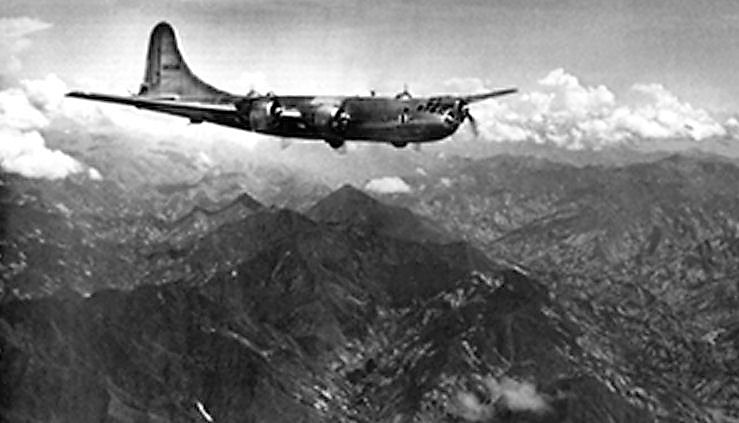 |
B-29s were withdrawn from airfields in China by the end of January 1945. Throughout this prior period, B-29 raids were also launched from China and India against many other targets throughout Southeast Asia, including a series of raids on Singapore and Thailand. On 2 November 1944, 55 B-29s raided Bangkok's Bang Sue marshalling yards in the largest raid of the war. Seven RTAF Nakajima Ki-43 Hayabusas from Foong Bin (Air Group) 16 and 14 IJAAF Ki-43s attempted intercept. RTAF Flt Lt Therdsak Worrasap attacked a B-29, damaging it, but was shot down by return fire. One B-29 was lost, possibly the one damaged by Flt Lt Therdsak. On 14 April 1945, a second B-29 raid on Bangkok destroyed two key power plants, and was the last major attack conducted against Thai targets.The B-29 effort was gradually shifted to the new bases in the Mariana Islands in the Central Pacific, with the last B-29 combat mission from India flown on 29 March 1945.
Due to the B-29's highly advanced design for its time, unlike many other World War II-era bombers, the Superfortress remained in service long after the war ended, with a few even being employed as flying television transmitters for the Stratovision company. The B-29 served in various roles throughout the 1950s. The Royal Air Force flew the B-29 as the Washington until phasing out the type in 1954. The Soviet Union produced an unlicensed reverse-engineered copy as the Tupolev Tu-4. The B-29 was the progenitor of a series of Boeing-built bombers, transports, tankers, reconnaissance aircraft and trainers including the B-50 Superfortress (the first aircraft to fly around the world non-stop) which was essentially a re-engined B-29. The type was finally retired in the early 1960s. The B-29 production total was 3,970 aircraft. Dozens of B-29s remain as static displays but only one example, Fifi, remains on flying status.
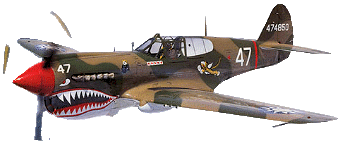
Famous Planes of the CBI Theater
Primary source of information for this page was Wikipedia
Additional information about Stinson L-5 provided by
James H. Gray, Sentinel Owners & Pilots Association
TOP OF PAGE
FAMOUS PLANES PHOTOS
CHINA-BURMA-INDIA THEATER
Copyright © 2016 Carl W. Weidenburner FLIGHTS
